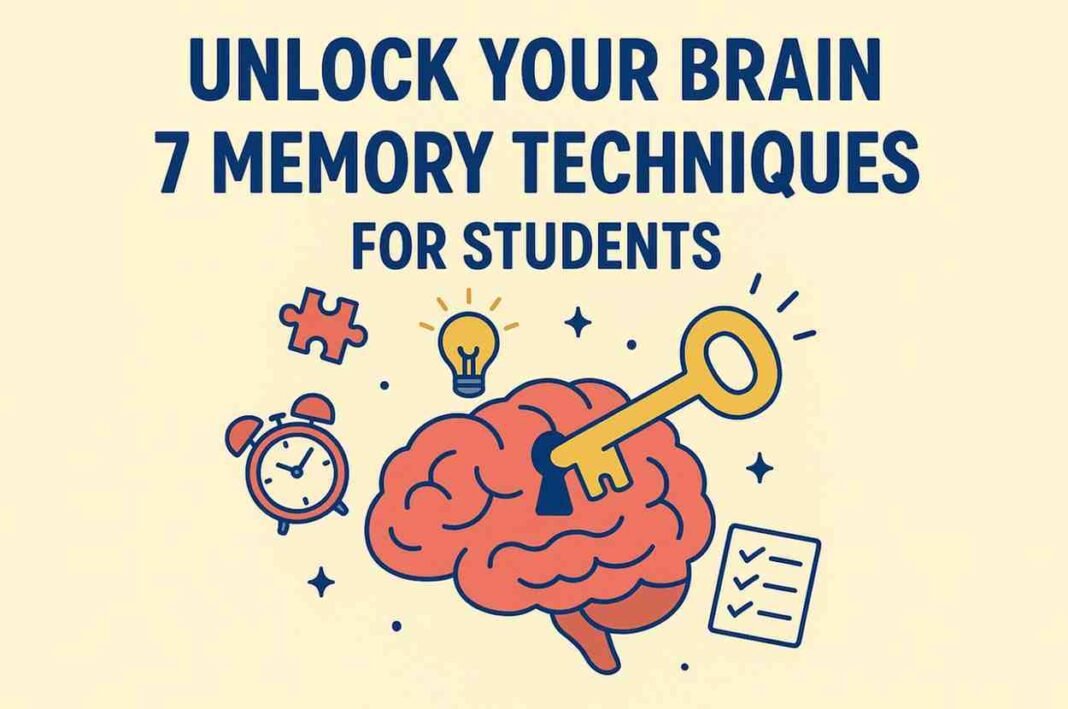In today’s fast-paced academic world, students face an overwhelming amount of information to absorb, understand, and retain. Whether it’s memorizing historical dates, scientific formulas, or vocabulary words, the challenge remains the same — how to make learning more effective and lasting. Fortunately, psychology and neuroscience have identified several practical memory techniques that can transform the way students study. From the classic Mnemonics and Chunking to creative Visualization and the Loci Method, these tools make studying not only easier but also engaging and fun.
1. The Power of Chunking
Chunking is one of the simplest yet most powerful techniques to boost memory. It involves breaking large pieces of information into smaller, digestible units. For instance, instead of trying to memorize a long string of numbers like 9588768939, you can group them as 9588-768-939. The brain naturally processes smaller clusters of data more efficiently, making recall much quicker. This approach works especially well for memorizing lists, equations, or complex sequences.
2. Mnemonics: Turning Learning Into Wordplay
Mnemonics are creative shortcuts that help convert dull facts into memorable cues. Using acronyms, rhymes, or catchy phrases can make dry information easier to recall. For example, the acronym VIBGYOR helps students remember the colors of the rainbow, while STEM stands for Science, Technology, Engineering, and Math. Students can also invent their own mnemonics — the more personal or funny they are, the better they stick in memory.
3. Association Method: Connect the Known With the New
Our brains are wired to remember things that connect with existing knowledge. The Association Method takes advantage of this natural mechanism by linking new information with familiar ideas. For example, to remember the word “catastrophe,” you might picture a mischievous cat knocking over a stack of dishes, symbolizing chaos or disaster. By turning abstract words into vivid associations, you create strong memory anchors.
4. Visualization: Seeing Is Remembering
Visualization is another powerful technique that transforms words or concepts into mental imagery. The more colorful, unusual, or exaggerated your image, the more effectively it will embed in memory. When learning the word “ostentatious,” for instance, imagine a peacock wearing a gold chain and sunglasses, standing proudly on a pile of jewels. This vivid mental picture helps the word’s meaning — showy or extravagant — stick instantly.
5. Mind Maps: Visual Learning Made Simple
Mind maps are a favorite among visual learners. They allow students to organize complex information around a central idea and explore related concepts through branching diagrams. To create one, start with a main topic — like “Respiratory System” — and draw sub-branches for “Airways,” “Lungs,” and “Gas Exchange.” Under each subtopic, add smaller branches such as “Nose,” “Trachea,” and “Bronchi.” Using colors and images enhances clarity and retention, while helping identify areas that need extra focus.
6. Spaced Repetition: Strengthening Long-Term Recall
Cramming may work for a short quiz, but for long-term retention, spaced repetition reigns supreme. This method involves reviewing material at gradually increasing intervals — for example, after one day, three days, a week, and then two weeks. Repeated exposure helps transfer information from short-term to long-term memory. Language learners, for instance, often use spaced repetition apps to memorize vocabulary effectively.
7. Loci Method: Building a Memory Palace
The Loci Method, also known as the Memory Palace technique, is one of the oldest and most fascinating memory strategies. It involves associating information with familiar physical locations. Imagine walking through your home, placing vivid mental images representing key facts at specific spots — a word on your sofa, a formula on your desk, or a date on the door. When recalling the information, simply “walk” through your memory palace to retrieve each item effortlessly.
Unlocking Your Brain’s Potential
The beauty of these techniques lies in their adaptability. Students can experiment with different combinations depending on the subject or their personal learning style. Mnemonics and visualization may suit language learners, while mind maps and chunking work well for analytical subjects. What matters most is consistency and creativity. By practicing these methods regularly, students can train their brains to absorb and recall information faster — turning study time into a more productive and enjoyable experience.








